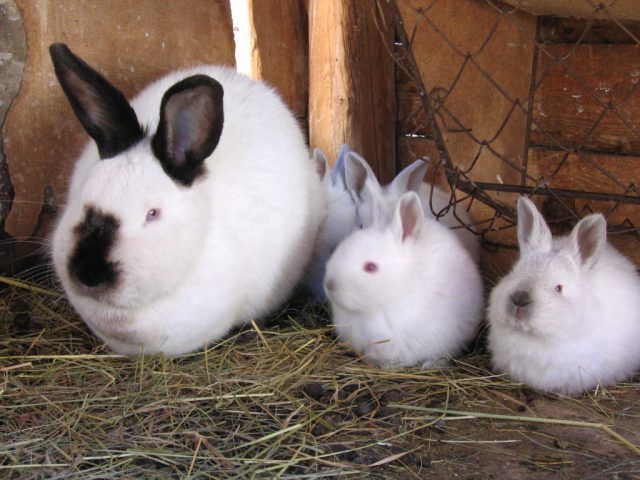Type the name of the breed you're looking for below
[wpdreams_ajaxsearchlite] Don't see the breed your're looking for? Click here and let us know!
Breed Characteristics
1 paw - breed exhibits the least amount of this characteristic
5 paws - breed exhibits most amount of this characteristic
Californian rabbit
| Origin | In the United States breeds are as widely raised, as easily recognized, or as all-around useful as the Californian. Each year hundreds, maybe thousands, of Californian trios take Grand Champion meat pen at fairs around the country. They are often finalists on the Best in Show table, and are widely raised for their meat and fur value both by large scale rabbitries and back yard breeders. You have to put your hands on a quality Californian to fully appreciate its smooth, solid build and fine coat. Californians should be judged “from the hind end forward.” The hindquarters pack the most meat, so it carries more points in the Standard than the midsection or shoulders. The body type should be as deep and full as possible. Looking at the rabbit from the side, you should see no dips in the smooth curve of the topline rising behind the ears and arching down to the tail. Your hands should not catch on the hips or feel any pinbones when you rub a Cal from front to back. The fur is to be a flyback that conforms to the ARBA commercial fur standard. Californians should be pure white with dark markings called smut on the “points” – nose, ears, feet, and tail. The eyes are ruby red. Colour on the “usable portion of the pelt” is a disqualification, because furriers preferred an all-white pelt. Colour of the points is to be “as near black as possible” – but black is not the only showable point colour! Most people don’t realize this, but blue and chocolate pointed Californians do appear in litters and can be shown, but are faulted for point colour other than black. The Californian colour is caused by the ch gene, often called the Himalayan gene. This is just one step up from albino; colour is restricted to the points. The pointed white colour is temperature sensitive: cold makes it darker and heat makes it lighter. (Notice that the points are farthest away from the internal heat source of the rabbit.) Californian rabbits in cooler climates will naturally have darker point colour, so some breeders in the south actually have “chiller room” rabbitries in which to grow out their show rabbits! This breed was developed in the 1920’s by George West of California. He crossed Himalayans with Standard Chinchillas and then added some New Zealand blood to achieve the size he wanted. Today only the New Zealand white surpasses the Californian in its popularity as a commercial rabbit. The Californian also contributed its genes to a specialized modern commercial breed called the Altex. |
Physical Attributes
| Weight | 8 - 12 lbs. (3.6 - 5.4 kg) |
| Ear Type | Erect |
| Fur Type | Flyback |
| Colours | Pointed white (black, chocolate, blue, lilac) |
| Appearance | White with black ears, nose, feet, and tail. Full-bodied with medium-length upright ears. |
| Other Considerations | Life Expectancy: 5-8 years Temperament: Gentle Commercial rabbit pellets are often recommended, though this is a disputed claim amongst rabbit rescue shelters and commercial breeders. Pellets are high in fat and protein needed for a healthy rabbit. Feed 1/2 cup of pellets per 5 pounds of body weight every day. Ensure a steady supply of fresh water or the rabbit may not eat the feed ration. For rabbits under 8 months of age, feed unlimited plain grass pellets. House rabbits may be fed 2 cups of fresh rinsed greens, (NO iceberg lettuce) vegetables (stay away from greens high in iron) should be given daily, and fresh fruit sparingly. Free choice hay, such as timothy-grass, should be unlimited and changed daily. Alfalfa hay should not be offered free choice to rabbits over 8 months of age because it is too rich in calcium. Many rabbits do very well in the home. They can be litter box trained and are quite fastidious groomers, they can also be trained to wear a harness and leash. Be aware that rabbits love to chew so make sure all wires are safely hidden or in protective plastic covers and understand that some of your furniture, books and baseboards may be nibbled. They can be contained in an exercise pen to prevent damage to your house. If you choose to cage your rabbit, make sure the cage is at least 2 feet by 2 feet by 4 feet. If the cage has a wire bottom make certain you give the rabbit a plank or sea grass mats to stand on so his feet won’t get damaged from being on the wire all the time. It is preferred that the bottom wire of the cage be 1/2 x 1/2 - large enough for the bunny berries to go through, but small enough to keep their feet and nails from being caught in the wire. Provide a hide box or shelter and plenty of straw for bedding. The rabbits are wonderful pets, with a very nice easy-going temperament. They enjoy empty oatmeal boxes, a juice can (paper) with the ends cut off and stuffed with hay, a bell hanging from the top of their cage. You should also provide chewing material, such as untreated pieces of lumber or small twigs from trees. Californians are an excellent meat rabbit breed. They produce large litters of 8-12 kits, which have a fast growth rate to fryer size (4-5 lbs)in 8–12 weeks. Californians are a breed developed for show and commercial purposes. |
| Best Kept In | Pen. Cage or Yard. |



